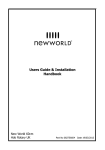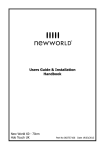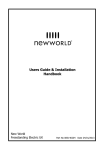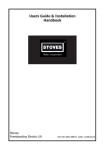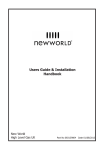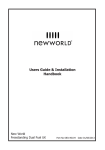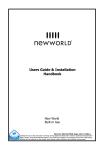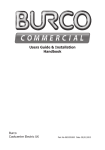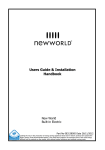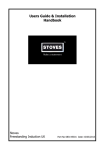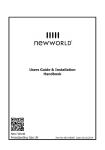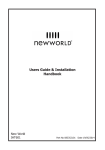Download New World 55HLGE
Transcript
Users Guide & Installation Handbook New World High Level Electric UK Part No 083139903 Date 17/06/2013 CONTENTS & INTRODUCTION CONTENTS • SAFETY • USING THE PRODUCT • CLEANING • INSTALLATION INSTRUCTIONS • TECHNICAL DATA • CUSTOMER CARE INTRODUCTION Thank you for buying this Britishbuilt appliance from us. This guide book is designed to help you through each step of owning your new cooker, from installation to use. Please read it carefully before you start using your product, as we have endeavored to answer as many questions as possible, and provide you with as much support as we can. WARRANTY Your new appliance comes with our 12-month guarantee, protecting you against electrical and mechanical breakdown. To register your appliance please call 0844 481 0182, complete the registration form included or register online at the web address located on the back page of this book. For full terms & conditions of the manufacturer’s guarantee, refer to the website on the back of this book. In addition, you may wish to purchase an extended warranty. A leaflet explaining how to do this is included with your appliance. Our policy is one of constant development and improvement, therefore we cannot guarantee the strict accuracy of all of our illustrations and specifications - changes may have been made subsequent to publishing. If, however, you should find something missing, or not covered, please contact our Customer Care team. Their number is located on the back page of this book. For customers outside the UK and Northern Ireland, please contact your local supplier. When you dial this number you will hear a recorded message and be given a number of options. This indicates that your call has been accepted and is being held in a queue. Calls are answered in strict rotation as our Customer care representatives become available. Alternatively, general information, spares and service information is available from our website. The address is located on the back page of this book. 3.010 SAFETY BEFORE USING THE PRODUCT Make sure that you have removed all packaging and wrapping. Some of the items inside this appliance may have additional wrapping. It is advised that you turn the ovens and/ or grill on for a short while. This will burn off any residues left from manufacturing. There may be a smell which accompanies this process - but this is nothing to worry about and is harmless. It is recommended that you wash the oven shelves, baking tray, grill pan and grill pan trivet before their first use in hot soapy water. This will remove the protective oil coating. WARNING! - The appliance and its accessible parts become hot during use. Care should be taken to avoid touching heating elements. Children less than 8 years of age shall be kept away unless continously supervised. This appliance can be used by children aged from 8 years and above and persons with reduced physical sensory or mental capabilities or lack of experience and knowledge if they have been given supervision or instruction concerning the use of the appliance in a safe way and understand the hazards involved. Children shall not play with the appliance. Cleaning and user maintenance shall not be made by children without supervision. WARNING! Unattended cooking on a hob with fat or oil can be dangerous and may result in fire. NEVER try to extinguish a fire with water, but switch off the appliance and then cover the flame with a lid or damp cloth. WARNING! - Danger of fire: Do not store items on the cooking surfaces. WARNING! - Servicing should be carried out only by authorised personnel. 5.120 SAFETY WARNING! - The appliance must never be disconnected from the mains supply during use, as this will seriously affect the safety and performance, particularly in relation to surface temperatures becoming hot and gas operated parts not working efficiently. The cooling fan (if fitted) is designed to run on after the control knob has been switched off. WARNING! Do not spray aerosols in the vicinity of this appliance while it is in operation. WARNING! - Do not store or use flammable liquids or items in the vicinity of this appliance. WARNING! Do not modify this appliance. WARNING! - Do not use harsh abrasive cleaners or sharp metal scrapers to clean the oven door glass since they can scratch the surface, which may result in shattering of the glass. WARNING! - Do not operate the appliance without the glass panel correctly fitted. WARNING! - There is a risk of electric shock, so always make sure you have turned off and unplugged your appliance before starting. Always allow the product to cool down before you change a bulb. WARNING! - Accessible parts may become hot when the grill is in use. children should be kept 5.120 SAFETY only. It must not be used away. for other purposes, for WARNING! - Never example room heating. place food, or dishes on the base of the main GENERAL oven, the element is here OVEN/GRILL Do and it will cause over • Always take care when removing food heating. from the oven as the area around the cavity may be hot. WARNING! - Do not • Always use oven gloves when hanmodify the outer panels dling any utensils that have been in the oven as they will be hot. of this appliance in any • Always make sure that the oven way. shelves are resting in the correct position between two runners. Do not WARNING! - This place the oven shelves on top of the highest runner, as this is not stable appliance must be and can lead to spillage or injury. earthed. • Always use the Minute Minder (if fitted) if you are leaving the oven WARNING! - The top unattended - this reduces the risk of element gets extremely food burning. hot when in use, so take Do Not care to avoid touching it. • Never place items on the door while it is open. WARNING - If the sur• Never wrap foil around the oven shelves or allow foil to block the flue. face is cracked, broken • Never drape tea towels near the oven or shattered, switch off while it is on; this will cause a fire the appliance to avoid hazard. • Never pull heavy items, such as turthe possibility of electric keys or large joints of meat, out from shock and call for a serthe oven on the shelf, as they may overbalance and fall. vice engineer’s visit. Caution: This appliance is for cooking purposes • Never use this appliance to heat anything other than food items and do not use it for heating the room. • Do not spray aerosols in the vicinity 5.120 SAFETY of this appliance while it is in operation. • Never leave cooking fat, or oil, unattended. • Do not store or use flammable liquids or items in the vicinity of this appliance. • • Do not modify this appliance. Never use commercial simmering aids, or heat diffusers, as they create excessive heat and can damage the surface of the hob. • Never use the hob for any other purpose than cooking food. • Always ensure that pan bases are dry and flat before using them on the hob. Plastic cooking utensils can melt if they come into contact with a warm hob. Never leave them close to, or on top of the hob. • Always position pans over the centre of the heat zone, and turn the handles to a safe position so they cannot be knocked or grabbed. Never leave any cook zone on without a pan covering it. This causes a fire hazard. • Always use pans which are no smaller than 100mm (4”), or no larger than 250mm (10”). Never use the hob surface as a chopping board or food preparation area, as this may lead to it becoming damaged. • Never put metal cooking utensils, cutlery, knives or other metal objects on the hob. They could become hot if they are near a cooking area which is in use. ELECTRIC HOB GENERAL Do • • • • Always match the size of pan to the size heat zone – do not use large pans on small zones or vice versa. • Always lift pans onto and off the hob, rather than sliding them across the surface, to avoid marks and scratches. • Never leave pans overhanging the edge of the hob. The surface of the hob is smooth. If pans are knocked they may move on the hob top. • If the appliance has solidplate elements, prime and season your hob before using it for the first time - see the Care & Cleaning section. • If the appliance has solidplate elements, never leave pan lids or decorative covers on top of the elements as any trapped moisture will lead to corrosion. • Never stare at the halogen elements (if fitted). This may impair your vision. • Never leave aluminium foil on the hob top, it reflects heat back into the element which leads to damage. Never heat up a sealed tin of food on the hob, as it may explode. Do Not • • If the appliance has a glass hobtop, never drag pans across the ceramic surface as this will lead to scratches and damage. Never use double pans, rim-based pans, old or misshapen pans, or any pan that is not stable on a flat surface. 5.120 SAFETY FIRE SAFETY ADVICE • Most kitchen fires occur when people are distracted or leave things unattended, so remember: Smother the fire with a fire blanket, or use a dry powder or carbon dioxide extinguisher • Remember: never use water on an electrical or cooking oil fire. If you’re called away from the cooker - by the phone or someone at the door, either take pans off the heat, or switch off your hob. Don’t let yourself be distracted while cooking. If you do have a fire in the kitchen, don’t take any risks - get everyone out of your home and call the Fire Brigade. If a pan catches fire: • Do not move it - it is likely to be extremely hot. • Turn off the heat if it’s safe to do so - but never lean over a pan to reach the controls. • If you have a fire blanket, put it over the pan. • If you have put the fire out, leave the pan to cool completely. Deep-fat frying presents more dangers in your kitchen. • Never fill a chip pan (or other deepfat fryer) more than one-third full of oil • Do not use a fire extinguisher on a pan of oil - the force of the extinguisher can spread the fire and create a fireball. If you have an electrical fire in the kitchen: • Pull the plug out, or switch off the power at the fuse box - this may be enough to stop the fire immediately 5.120 USING THE HOB - ELECTRIC (SOLID) Before using the hob for the first time, it should be primed and seasoned - refer to the instructions in the cleaning section. To switch on a hotplate element Turn the selected hotplate control knob clockwise or anti-clockwise, depending on the required setting. The high speed hob ring(s) are identified by its central red spot. A high speed hob ring has a faster response time. To switch off, return the control knob to the “off” position. Using the hob Do not operate the hotplate elements without a pan on, or leave them running after removing a pan. The electric hob uses a sealed hob system where heat is transferred by conduction. Decorative covers should not be used over the hotplates as these can trap moisture and cause intense heat. When you have finished cooking check that all controls are in the off position. USING THE GRILL - ELECTRIC Caution: Accessible parts may be hot when the grill is used. Young children should be kept away. Make sure that the grill pan is first pushed back to the rear stop position and engage onto the grill pan runners before pulling forward to the front stop position. Preheating When you have finished grilling, check that the control knob is returned to the ‘off’ position. Aluminium foil Using aluminium foil to cover the grill pan and/or trivet, or putting items wrapped in foil under the grill can create a fire hazard; also, the high reflectivity of aluminium foil can damage the grill element. Always preheat the grill for about 3 minutes, for best cooked results. Grilling The temperature of the grill is variable, and can be adjusted by turning the grill control to the required setting. Grilling can also be adjusted by use of the trivet there are three different grilling positions, as the grill trivet, which is in the grill pan, may be inverted to give a high or low position or the trivet may be removed, as detailed below: 1. The HIGH trivet position is suitable for toasting bread. 2. The LOW trivet position is suitable for grilling all types of meat & fish. 3. With the grill trivet removed the food is placed directly on the base of the grill pan, eg; when cooking whole fish or browning dishes such as cauliflower cheese. Food for grilling should be positioned centrally on the trivet & the grill pan should be pushed fully in to its stop position. Never allow fat to build up in the grill pan as this creates a fire hazard. If cleaning the grill pan when it is hot, use oven gloves to move it. 7.140 USING THE MAIN OVEN - ELECTRIC Accessible parts may be hot when the oven is used. Young children should be kept away. To switch on the oven Turn the oven control knob(s) to the required setting. The red thermostat indicator (if fitted) will come on until the selected temperature is reached and then go off; it will turn on and off periodically as the thermostat operates to maintain the selected temperature. Manual Operation (fanned only) The programmer must be set to manual operation before the main oven can be used. If A (Auto) is on the programmer display, return the oven to manual by pressing the up and down buttons simultaneously Any programme which has been set is cancelled. The cooling fan The cooling fan may operate when the main oven is on and may continue to operate for a period after the oven has been switched off. To switch off, return the control knob to the off position. OVEN FURNITURE When using the oven The oven shelf must be positioned with the upstand at the rear of the oven and facing upwards. As part of the cooking process, hot air is expelled through a vent in the oven. When opening the oven door, care should be taken to avoid any possible contact with potentially hot air, since this may cause discomfort to people with sensitive skin. We recommend that you hold the underneath of the oven door handle. Oven shelves Position baking trays and roasting tins on the middle of the shelves. Baking tray and roasting tins For best cooked results and even browning, the recommended size baking trays and roasting tins that should be used are as follows; PREHEATING Baking tray 350mm x 250mm Fanned oven This size of baking tray will hold up to 12 small cakes. When cooking sensitive items such as souffle and Yorkshire puddings or, when cooking bread, we recommend that the oven is preheated until the neon switches off for the first time. For any other types of cooking, a preheat may not be required. Roasting tin 370mm x 320mm We recommend that you use good quality cookware. Poor quality trays and tins may warp when heated, leading to uneven baking results. Conventional oven Preheating is always required 9.100 USING THE MAIN OVEN - ELECTRIC Slow cooking ( Setting or 100°C) • Make sure that frozen foods are thoroughly thawed before cooking. • Do not slow cook joints of meat or poultry weighing more than 2¼kg/4½lb. • Preheat the oven to 170°C and cook for 30 minutes, then adjust the oven control to or 100°C (slow cook setting) for the remainder of the cooking time. • Slow cooking times will be about 3 times as long as conventional cooking times. • Do not open the oven door unnecessarily during slow cooking, as this will result in heat loss at low temperatures. • Always use dishes with tightly fitting lids. To rectify badly fitting lids, place foil over the dish underneath the lid. Aluminium foil Use foil only to cover food or cooking dishes, using foil to cover the shelves or oven base creates a fire hazard. Cooking with a fanned oven As this is a high efficiency oven, you may notice the emission of steam from the oven when the door is opened. Please take care when opening the door. If you are used to cooking with a conventional oven you will find a number of differences to cooking with a fan oven which will require a different approach: There are no zones of heat in a fan oven as the convection fan at the back of the oven ensures an even temperature throughout the oven. This makes it ideal for batch baking - eg; when planning a party as all the items will be cooked within the same length of time. Foods are cooked at a lower temperature than a conventional oven, so conventional recipe temperature may have to be reduced. Please refer to the conversion chart. Preheating is generally not necessary as a fan oven warms up quickly. There is no flavour transference in a fan oven, which means you can cook strong smelling foods such as fish at the same time as mild foods - eg; milk puddings. When batch baking foods that will rise during cooking - eg; bread - always ensure that enough space has been left between the shelves to allow for the rise. Notes: When 2 or more shelves are being used, it may be necessary to increase the cooking time slightly. Because the 2 oven shelves are wider than in many ovens, it is possible to cook 2 items per shelf - eg; 2 victoria sandwiches or 2 casseroles. Although you need to keep in mind the points ‘To help the air circulate freely’ with careful choice of dishes and tins, it is possible to cook a complete meal, and perhaps something else for the freezer, in the oven at the same time. When roasting meats, you will notice that fat splashing is reduced, which is due in part to the lower oven temperatures, and will help keep cleaning of the oven to a minimum. Because a fan oven has an even temperature throughout the oven, there is no need to follow the shelf positions given in the baking guide. 9.100 USING THE MAIN OVEN - ELECTRIC There is no need to interchange dishes onto different shelves part way through cooking, as with a conventional oven. To help the air circulate freely Position the shelves evenly within the oven and maintain a clearance from the oven roof and base. If more than one cooking dish or baking tray is to be used on a shelf, leave a gap of at least 25mm between the items themselves and the oven interior. Defrosting and cooling in the main oven To defrost frozen foods, turn the main oven control to the defrost position, place the food in the centre of the oven and close the door. To cool foods after cooking prior to refrigerating or freezing, turn the main oven control to the defrost position and open the door. Defrosting times Small or thin pieces of frozen fish or meat - eg; fish filets, prawns & mince will take approximately 1 - 2 hours. Be safe Do not defrost stuffed poultry using this method. Do not defrost larger joints of meat and poultry over 2kg/4lb using this method. Never place uncooked food for defrosting next to cooked food which is to be cooled, as this can lead to cross contamination. Defrosting meat, poultry, and fish can be accelerated using this method but make sure they are completely thawed before cooking thoroughly. Place meat and poultry on a trivet in a meat tin. MAIN OVEN BAKING GUIDE Cooking times & temperatures The temperature settings and times given in the baking guide are based on dishes made with block margarine. If soft tub margarine is used it may be necessary to reduce the temperature setting. Allow enough space between shelves for food that will rise during cooking. Do not place items on the oven base as this will prevent air circulating freely. Placing the food in a single layer will reduce the thawing time. A medium sized casserole or stew will take approximately 3 - 4 hours. A 1½kg/3lb oven ready chicken will take approximately 5 hours, remove the giblets as soon as possible. 9.100 USING THE MAIN OVEN - ELECTRIC Note: This is a high efficiency oven, therefore some adjustment will have to be made to conventional cooking temperatures. The table below shows conventional cooking temperatures, ‘A’ efficiency temperatures and gas marks. For optimum results, conventional temperatures need to be converted to ‘A’ efficiency temperatures. For example, an item which would normally cook at a conventional temperature of 180 °C, will now cook at the ‘A’ efficiency temperature of 160°C. Conventional temperature ‘A’ Efficiency Oven (°C) (°C) 100 110 130 140 150 160 180-190 200 220 230 250 100 110 120 130 140 150 160 170 180 190 200 Food Type Cakes Temperature settings (°C) Conv Gas Mark 1/4 1/4 1/2 1 2 3 4-5 6 7 8 9 Time Approx. Shelf Position Fanned Small cakes Victoria sandwich Semi rich fruit cake Christmas cake 190 180 150 150 160 160 125 125 15 - 25 20 - 30 2.5HRS - 3HRS 2.5HRS - 3HRS 2-4 3 2 2 Puddings Bread and butter pudding Fruit crumble 170 200 150 175 45 - 1hr 40 - 1hr 3 3 Miscellaneous Yorkshire pudding: large small Shortcrust pastry 220 220 200 200 200 180 40 - 48 15 - 20 Depends on filling 4-5 4-5 4-5 9.100 USING THE MAIN OVEN - ELECTRIC Traditional fruit cakes Roast turkey It should be remembered that ovens can vary over time, therefore cooking times can vary, making it difficult to be precise when baking fruit cakes. Roasting turkey involves cooking two different types of meat - the delicate light breast meat, which must not be allowed to dry out, and the darker leg meat, which takes longer to cook. It is necessary therefore, to test the cake before removal from the oven. Use a fine warmed skewer inserted into the centre of the cake. If the skewer comes out clean, then the cake is cooked. The turkey must be roasted long enough for the legs to cook, so frequent basting is necessary. The breast meat can be covered once browned. • Follow the temperatures suggested in the recipe and then adjust accordingly to the conversion table. • Always make sure that the turkey is completely thawed and that the giblets are removed before cooking. • Do not attempt to make Christmas cakes larger than the oven can cope with, you should allow at least 25mm (1”) space between the oven walls and the tin. • Turkey should be roasted at 160°C - 180°C (fanned) or 180°C - 200°C (conventional) for 20 minutes per 450g (1 lb), plus 20 minutes, unless packaging advises otherwise. • Always follow the temperatures recommended in the recipe. • • To protect a very rich fruit cake during cooking, tie 2 layers of brown paper around the tin. The turkey can be open roasted, breast side down, for half of the cook time, and then turned over for the remainder of the cooking time. • If the turkey is stuffed, add 5 minutes per 450g (1 lb) to the cooking time. • If roasting turkey covered with foil, add 5 minutes per 450g (1 lb) to the cooking time. • We recommend that the cake tin is not stood on layers of brown paper, as this can hinder effective circulation of air. • Do not use soft tub margarine for rich fruit cakes, unless specified in the recipe. • Always use the correct size and shape of tin for the recipe quantities. To test if the turkey is cooked, push a fine skewer into the thickest part of the thigh. If the juices run clear, the turkey is cooked. If the juices are still pink, the turkey will need longer cooking. 9.100 USING THE MAIN OVEN - ELECTRIC Roasting guide Notes: The times given in the roasting guide are only approximate, because the size and age of the bird will influence cooking times as will the shape of a joint and the proportion of the bone. • When cooking stuffed meat or poultry calculate the cooking time from the total weight of the meat plus the stuffing. • For joints cooked in foil or covered roasters, and for lidded casseroles, add 5 minutes per 450g (1lb) to the calculated cooking time. • Smaller joints weighing less than 1.25kg (2½lb) may require 5 minutes per 450g (1lb) extra cooking time. • Position the oven shelf so that the meat or poultry is in the centre of the oven. • It is recommended that the appliance is cleaned after open roasting. Frozen meat should be thoroughly thawed before cooking. For large joints it is advisable to thaw over night. Frozen poultry should be thoroughly thawed before cooking. The time required depends on the size of the bird - eg; a large turkey may take up to 48 hours to thaw. Use of a trivet with a roasting tin will reduce fat splashing and will help to keep the oven interior clean. Alternatively, to help reduce fat splashing, potatoes or other vegetables can be roasted around the meat/poultry. Cook in main oven at: Approximate Cooking Time 160°C - 180°C (fanned) (preheated oven) 180°C - 200°C (conventional) Beef Rare Medium Well done 20 minutes per 450g (1lb), plus 20 minutes 25 minutes per 450g (1lb), plus 25 minutes 30 minutes per 450g (1lb), plus 30 minutes Lamb Medium Well Done 25 minutes per 450g (1lb), plus 25 minutes 30 minutes per 450g (1lb), plus 30 minutes Pork 35 minutes per 450g (1lb), plus 35 minutes Poultry 20 minutes per 450g (1lb), plus 20 minutes 9.100 CLEANING General • It is important to clean the product regularly as a build up of fat can affect its performance or damage it and may invalidate your guarantee. • Always switch off your appliance and allow it to cool down before you clean any part of it. • Do not use undiluted bleaches, products containing chlorides, wire wool or abrasive cleaners on aluminium, stainless steel, or plastic/ painted parts as they can damage the appliance. Nylon pads can also be unsuitable. • Take extra care when cleaning over symbols on fascia panels. Excessive cleaning can lead to the symbols fading. • If your product is fitted with stainless steel cladded stips. You may notice a small white residue on the outer edges, this can be removed with a non abrasive wipe. • Some foods are corrosive eg; vinegar, fruit juices and especially salt - they can mark or damage the metal if they are left on the surface. • Baby oil can be used to restore stainless steel finishes - but only use a few drops. Don’t use cooking oils as they can contain salts, which will damage the metal. • Do not use steam cleaners. Enamel surfaces & parts • Clean with warm, soapy water and a clean cloth. • If larger splashes of fat do not readily disappear, you can use a mild cream cleaner to remove them. More stubborn marks can be removed using a soap filled pad. • Rinse well and dry with a soft clean towel or cloth. • Do not use steam cleaners. Painted & Plastic parts Glass parts • Only use a clean cloth wrung out in hot soapy water. • Do not use abrasive cleaners, wire or nylon cleaning pads on these parts. WARNING:- Do not use harsh abrasive cleaners or sharp metal scrapers to clean the oven door glass since they can scratch the surface, which may result in shattering of the glass. Stainless steel & Aluminium surfaces • Only use a clean cloth wrung out in hot soapy water, and dry with a soft cloth. • Stubborn marks can be removed using a stainless steel cleaner. Supplies can be purchased from the Customer Care Centre. • Sharp objects can mark the surface of stainless steel, but will become less noticeable with time. • Wipe any spillage immediately, taking care to avoid burning your hands • Only use a clean cloth wrung out in hot soapy water, or a specialist glass cleaner. Rinse away any excess cleaner and dry with a soft cloth. Chrome plated parts • Use a moist soap filled pad, or place in a dishwasher 12.000 CLEANING REMOVING OVEN PARTS FOR CLEANING Inner Door Glass (glass doors only) • The inner door glass panel can be removed for cleaning but it must be replaced the right way up. If there is any writing on the glass, you must be able to read it clearly when the cavity doors are open. • Always make sure that the glass is pushed fully into the Stop position. • To remove the glass panel, open the door wide, hold the top and bottom edges and slide out. that it is replaced immediately. Shelf Runners • Shelf runners can be removed to enable you to clean them thoroughly. Make sure they are cool to touch and then grasp the runners and slide out of their hanging holes. Pull out to clean • Warning: Do not operate the appliance without the glass panel correctly fitted. • For your safety, glass door panels are made of toughened glass. This ensures that, in the unlikely event that a panel breaks, it does so into small fragments to minimise the risk of injury. Please take care when handling, using or cleaning all glass panels, as any damage to the surfaces or edges may result in the glass breaking without warning or apparent cause at a later date. Should any glass panel be damaged, we strongly recommend 12.100 CLEANING ELECTRIC HOB • You can restore the hotplates by using a solid plate cleaner but take care to avoid the red spots on elements. • To prime: Switch on each element in turn for a short while (with no pan on it) at a medium - high setting. This will harden and burn off the coating. • To season: Heat the element for 30 seconds at a medium setting then switch off. Use a minimum amount of unsalted vegetable oil, on a dry cloth or paper towel, and apply a thin coat of oil to the element surface. Wipe off the excess and heat the element for one minute. Ceramic glass hobs • The ceramic hob top can be cleaned using a clean, damp cloth or kitchen paper. Do not use a used dishcloth or sponge as they can leave a film of detergent on the surface which can lead to discoloration. Please ensure that the elements are cooled fully to avoid steam burns. • You can use a specialist ceramic cleaner to restore the surface, but use sparingly to avoid coating the hob top too thickly. Too much cream cleaner will lead to discolouration. Use a dry, clean cloth to polish the surface. • For stubborn marks, a specialist hob scraper can be used. • Do not use steam cleaners or highpressure cleaning equipment. • Regular cleaning will prevent any salts or minerals from accumulating on your hob and discolouring the glass. • Wipe any spillage as soon as possible. • Clean the hob top as regularly as possible, this will prevent any build up of grease which may be a fire hazard. Solid plate hobs • Prime and Season - this helps maintain the finish of the elements. • Use a damp, clean cloth to wipe the solid plate, making sure that you follow the circular grooves and avoid damaging the red spots. Make sure that you allow the hotplate to dry before use by switching on the elements at a low heat. 12.210 INSTALLATION INSTRUCTIONS ASSEMBLE GRILL Fitting the grill canopy Fixing screws and washers that are not loosely assembled in position are in the plastic bag in the oven pack. 1. Remove the electrics cover box from the rear of the cooker & keep it & its self tapping fixing screws to hand. 2. There are 2 sets of screws in the rear of the cooker which will secure the splash plate (through the uprights) onto the rear of the cooker. 3. Loosen the lower screws of each set in the back of the cooker, until some of the thread is showing. 4. Remove the upper screws from each set and keep to hand. Pick up the splashplate and grill canopy and lower it onto the back of the cooker so the slots in the uprights locate over the loosened screws. 5. Replace the upper screws through the keyhole slots and tighten all screws in turn. 6. Make the electrical connection - the grill connector, protruding from the bottom of the left hand upright (as viewed from the rear), should be fitted to its mating half in the rear service panel just below the upright. Ensure any excess cable is pushed up into the upright prior to fitting the cover box. 7. Refit the electrics cover box by straightening the top face (indicated by slots) & securing with its self tapping screws thus covering the electric connection & the bottom of the upright. Fit the grill shelf - If the shelf has mounting holes: 1. Unscrew the 4 fasteners securing the grill element cover to the grill canopy - these are located on the underside of the canopy. 2. Offer the grill shelf up to the underside of the grill canopy, with the rubber endcaps right up against the splashplate. Locating the shelf on the exposed protruding M4 screws, secure with the fasteners. - If the shelf has mounting slots: 1. Loosen but do not remove the 4 fasteners securing the grill element cover to the grill canopy - these are located on the underside of the canopy. 2. With some thread visible, slide the shelf, with it’s rubber endcaps against the splashplate, under the fasteners on one side to locate it. 3. Push the other end under the fasteners on the other side of the canopy, ap plying some pressure to enable loca tion. Tighten all 4 fasteners to fix in place. 4. Retighten all fasteners to secure the shelf. Fit the grill pan Place the grill pan onto the grill pan runners and push to the back stop position, raise the front edge of the grill pan to engage it onto the grill pan runners. The grill pan can now be pulled forwards to fit the front stop position. 13.140 INSTALLATION INSTRUCTIONS CONNECT TO THE ELECTRICITY SUPPLY Your appliance will be fitted with one of the two terminal blocks below, Block A, Block B Warning: This appliance must be earthed. This appliance is not intended to be operated by means of an external timer or separate remote control system. The appliance must be installed by a competent electrician using a double pole control unit of 32 ampere minimum capacity with 3mm minimum contact separation at all poles. We recommend that the appliance is connected by a competent person who is a member of a competent persons scheme. 1. Access to the mains terminal is gained by opening the terminal block cover at the rear of the appliance (use a small flat-bladed screwdriver). 2. Connection should be made with 6.0mm2 flexible twin and earth cable. 3. First strip the wires, then push the cable through the cable clamp in the terminal block cover. 4. Connect the cable to the terminal block and tighten the cable clamp screw (see diagram). 5. Close the terminal box, ensuring that the cover is engaged on the locking tabs. 13.140 TECHNICAL DATA Electrical supply/load 220 - 240V ~ 50Hz 50cm with solid hotplate = 8275-9850W 55cm with solid hotplate = 8360-9950W Countries of destination GB - Great Britain, IE - Ireland Warning: This appliance must be earthed. Databadge is located at the bottom of the front frame, behind the door. 14.107 CUSTOMER CARE FAQs What parts of the appliance can be washed in a dishwasher? • Any enamelled parts such as the grillpan can be cleaned in a dishwasher, as can oven shelves and shelf guides. duce condensation when the oven is cooling down with food inside. Should the cooling fan continue to run once the appliance has been switched off? • What parts must NOT be cleaned in a dishwasher? • Parts such as burner skirts and caps, control knobs and any cast iron items must not be cleaned in a dishwasher, they should be cleaned with hot soapy water and a nylon brush once they are cool enough. There’s been a power failure and the product won’t work. • Switch off the electricity supply. • When the power returns switch the electricity supply back on and re-set any programmer/clock to the correct time of day. My oven is a single combined oven and grill - can I use both functions together? • No. You can only use one or the other. Why is there condensation on the doors? • Condensation is caused by hot, moist air meeting a cooler surface (i.e. the oven door). You cannot always prevent it, but you can minimise it when it happens by doing the following: • Pre-heat the oven at a high temperature before putting food in the oven, and cover the food you are cooking wherever possible. • Whenever you can, cook wet foods at higher temperatures. • Don’t leave food in the oven to cool down. • Automatic cooking will normally pro- Yes. This is to make sure that you can always touch the control knobs to make temperature adjustments, and turn your appliance off. What is a Multifunction oven? • A multifunction oven combines a variety of features, which are explained fully earlier in this book (if fitted), it allows you more flexibility when cooking. The neon on my appliance keeps going out and coming back on again - is this right? • Yes. In most cases the neon (if fitted) will cycle on and off to show that oven is maintaining your temperature choice. Call Customer Care for a Service Engineer’s visit if: • You find that the oven becomes hotter at a particular temperature - the thermostat may need replacing. • The cooling fan fails to work. 15.010 CUSTOMER CARE CUSTOMER CARE WEB SHOP Having purchased a superior cooker, hob or hood from us, you’ll naturally want to keep it looking great. And who better to help you care for it than the manufacturer? We offer an extensive range of accessories, components and cleaning products which, will instantly give your cooker a good as new look. range of Bake ware and Cookware essentials including Roasting Pans, Cake Tins and Non-Stick Cooking Liners. For all enquires, please visit our Web Shop at www.gdhaonline.co.uk or call the Spares Sales Team on 0844 815 3745. For countries outside the UK, please contact your local service agent. In addition to the list of our most popular products below, we also have an exciting Product Description Where used Purpose Ceramic Hob Cleaner All Ceramic glass hobs including Induction Enables easier cleaning of your ceramic hob. Prevents build up of mineral deposits. Best used with Ceramic Hob Scraper Kit. 300ml bottle. Ceramic Hob Scraper kit All Ceramic glass hobs including Induction Ideal for removing cooked on marks from ceramic glass hobs Best used with Ceramic Hob Cleaner Sealed Hotplate Conditioner All sealed/solid plate hobs Restores the sleek matt black finish to solid hotplates Multipurpose Kitchen Cleaner General kitchen cleaner Excellent multipurpose cleaner, For use around the kitchen. 500ml bottle. Oven Cleaner All cooking appliances. Cuts through grease & burnt on grime. 500ml bottle Restor-A-Cloth All cooking appliances. Chemical free cleaning cloth Ideal for cleaning & polishing glass & stainless steel Stainless Steel Cleaner All stainless steel parts Oil based cleaner. Perfect for removing stubborn & greasy marks. 300ml bottle. Rectangular carbon filters Cooker Hoods New filters, help to maintain efficient cooker hood operation and keep your Kitchen odour free Round Carbon Filters Cooker Hoods New filters, help to maintain efficient cooker hood operation and keep your Kitchen odour free 15.030 CUSTOMER CARE CHANGING LIGHT BULBS (where fitted) Warning: There is a risk of electric shock, so always make sure you have turned off and unplugged your appliance before starting. Always allow the product to cool down before you change a bulb. Not all appliances have the same number and type of bulbs. Before replacing your bulb, open the oven door and see which type you have. Then use the table to help you change your bulb correctly. Bulbs can be purchased from hardwarestores (always take the old bulb with you). Please remember that bulbs are not covered by your warranty. No of Lamps Instructions 1 Remove the oven shelves. Remove the loose oven back by unscrewing the 4 securing screws (one at each corner) and remove (Where fitted). Unscrew the lens cover by turning anticlockwise. Remove the bulb and replace. Replace the lens cover and oven back. 15.040 Please keep this handbook for future reference, or for anyone else who may use the appliance. Please keep this handbook for future reference, or for anyone else who may use the appliance. Please keep this handbook for future reference, or for anyone else who may use the appliance. CUSTOMER CARE To contact New World about your appliance, please call Warranty Registration 0844 481 0182 to register your appliance Customer Care Helpline 0844 815 3747 in case of difficulty within the UK Alternatively general, spares and service information is available from our website at www.newworldappliances.co.uk Please ensure that you have the product’s model no and serial no available when you call. These can be found on the silver data label on your product which is located: Ovens High-level grill products Hobs Open the door; adjacent to the oven cavity Inside the base compartment On the underside of the product Enter appliance numbers here for future reference: Model No Serial No SERVICE RECORD Date of purchase Installed by Installation Date Part(s) replaced Engineer’s name Place of purchase: Date For customers outside the UK and Northern Ireland, please contact your local supplier. Glen Dimplex Home Appliances, Stoney Lane, Prescot, Merseyside, L35 2XW




























